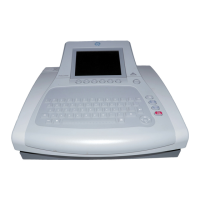
Do you have a question about the GE MAC 3500 and is the answer not in the manual?
| Battery Life | Up to 4 hours |
|---|---|
| Lead Configuration | 12-lead |
| ECG Channels | 12 |
| Battery Type | Rechargeable lithium-ion |
| Printer | Integrated thermal printer |
| Parameters | ECG, SpO2, NIBP, Respiration, Temperature |
| ECG | Yes |
| SpO2 | Yes |
| NIBP | Yes |
| Respiration | Yes |
| Temperature | Yes |
| Type | Electrocardiograph |
| Weight | 6.4 kg |
| Connectivity | USB |
| Data Storage | Internal memory |
| Paper Size | A4 |
| Power Supply | AC 100-240V, 50/60 Hz |
Details about the manual's structure, revision history, purpose, and audience.
Lists other documents relevant to the product's installation and use.
Explains the significance of hazard and safety warning terms used in the manual.
Provides critical safety information and precautions for operating the equipment.
Defines the manufacturer's responsibility regarding safety and performance.
Explains the meaning of various symbols found on the equipment or packaging.
Provides essential information for service personnel, including requirements and identification.
Provides a high-level overview of the MAC 3500 system's features and capabilities.
Illustrates and identifies key components visible from the side of the system.
Illustrates and identifies key components visible from the back of the system.
Identifies and describes the function of various connectors on the system.
Introduces the chapter's content on system assembly and accessory setup.
Covers the process of assembling the system and optional accessories onto a trolley.
Details how to adjust the height of the MAC Series Trolley.
Provides steps to secure the MAC 3500 unit onto the trolley assembly.
Guides the installation of an optional external modem kit onto the trolley.
Explains the procedure for installing the magnetic card reader.
Details the steps for installing the barcode reader onto the trolley.
Helps narrow down service problems by identifying replaceable assemblies and their diagrams.
Illustrates physical I/O connections between the PCB and external devices.
Details connections for the LVDS/LED display assembly.
Provides systematic steps and checks for isolating common equipment faults.
Details how to run system diagnostic tests to verify component functionality.
Addresses specific equipment issues, such as ECG data noise.
Guides troubleshooting for unacceptable noise levels in ECG data.
Lists common system error messages and their corresponding solutions.
Provides answers to common user questions regarding operation and maintenance.
Details the pinouts and signals for various input/output connectors.
Lists input/output signals for various connectors on the CPU PCB.
Emphasizes the importance of regular maintenance for equipment functionality.
Covers procedures for inspecting and cleaning the equipment.
Outlines procedures for checking the electrical safety of the unit.
Details the steps for replacing Field Replaceable Units (FRUs).
Lists procedures for checking system functionality after maintenance or replacement.
Provides information on how to order replacement parts and kits.
Lists and illustrates various Field Replaceable Units (FRUs) for the system.
Illustrates the parts of the upper level assembly.
Details parts within specific assemblies like display and KISS pump.
Lists available keyboard part numbers for different languages.
Lists available barcode scanner kits for the system.
Lists available card reader kits for the system.
Lists available modem kits for the system.
Lists available wireless server options for the system.
Lists available power cords for different regions.
Lists components and accessories for the MAC 3500 trolley.
Lists various kits containing FRUs for specific repairs or upgrades.
Describes the fundamental type and configurations of the electrocardiograph.
Details ECG interpretation, measurements, storage, and sampling rates.
Specifies communication options and compatibility with the MUSE system.
Provides specifications for the system's display type, resolution, and data shown.
Details the specifications of the thermal writer, including speed and resolution.
Describes the type and features of the system's keyboard.
Covers power supply, voltage, current, battery type, and capacity.
Lists the physical dimensions and weight of the system.
Specifies operating and storage conditions for temperature, humidity, and pressure.
Provides dimensions and weight specifications for the trolley.
Details specifications for the magnetic card reader.
Lists specifications for the barcode scanner.
Introduces the chapter on component compatibility.
Lists compatible display assemblies and FRU kits for different circuit boards.
Shows compatibility between main boards, software versions, and comm boards.
Identifies valid upgrade paths for software versions on supported main boards.
Specifies software version compatibility for the -008 CPU main board.
Discusses system compliance with EMC regulations and potential issues.
Provides manufacturer's declaration on electromagnetic emissions and environment.
Provides manufacturer's declaration on electromagnetic immunity and environment.
Specifies recommended distances for RF equipment to avoid interference.
Lists cables and accessories that comply with EMC standards.
Provides an alphabetical listing of topics covered in the manual.